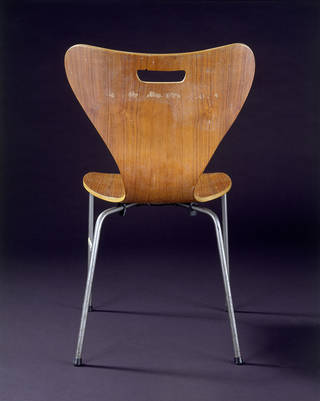This photograph of model Christine Keeler posed naked astride a modern plywood chair is an iconic image of the 1960s. It was taken in May 1963, at the height of public attention surrounding the relationship between the teenage Keeler and married politician John Profumo, then Secretary of State for War. In what became known as 'The Profumo Affair', the revelations of their relationship scandalised the Conservative government and the British establishment, causing Profumo to resign from office and bringing notoriety to Keeler.

The photo was the last shot on a 12-exposure film, taken in less than five minutes by Lewis Morley during a nude publicity shoot (intended to promote a proposed film about the scandal, The Keeler Affair). While the film was never actually released, Morley's photograph was leaked to the Sunday Mirror. Despite being taken at a time of increased sexual freedom and women's liberation, the image raises questions about exploitation. The chair, a cheap model Morley used to put his sitters at ease, was in this instance used to conceal Keeler's nakedness. Both the chair and the photograph are now in the V&A's collection.
Morley recalls:
This photograph was one of a series of publicity shots for an intended film which never saw the light of day. It was not until 1989 that a film of the 1963 happenings was released under the title 'Scandal'. The photographic session took place in my studio, which at that time was on the first floor of the 'Establishment', a satirical night club, part-owned by Peter Cook of Beyond The Fringe fame. The satirical sketches took place on a small stage on the ground floor of the club. The Dudley Moore Trio played Jazz in the basement.

During the session, three rolls of 120 film were shot. The first two rolls had Christine sitting in various positions on the chair and on the floor, dressed in a small leather jerkin. It was at this point that the film producers who were in attendance demanded she strip for some nude photos. Christine was reluctant to do so, but the producers insisted, saying that it was written in her contract. The situation became rather tense and reached an impasse. I suggested that everyone, including my assistant, leave the studio. I turned my back to Christine, telling her to disrobe, sit back to front on the chair. She was now nude, fulfilling the conditions of the contract, but was at the same time hidden.
We repeated some of the poses used on the previous two rolls of film. I rapidly exposed some fresh positions, some angled from the side and a few slightly looking down. I felt that I had shot enough and took a couple of paces back. Looking up I saw what appeared to be a perfect positioning. I released the shutter one more time, in fact, it was the last exposure on the roll of film.

Looking at the contact sheet, one can see that this image is smaller than the rest because I had stepped back. It was this pose that became the first published and most used image. The nude session had taken less than five minutes to complete. It wasn't until I developed the film that I discovered that somehow I had misfired one shot and there were only eleven images on a twelve exposure film. How this came about is a mystery to me.
The chair

The chair on which Keeler sat for her portrait has often been misidentified as the classic Danish model 3107 chair designed by Arne Jacobsen. In fact, it was a 'knock-off', or imitation, of the original design, though still made in Denmark. Comparing them side by side, it's easy to spot the difference. The plywood used in the copy is much thicker and less subtly moulded. The cinched "waist" of the chair is more pronounced, and the front of the seat is set back too far. Unlike Jacobsen's chair, this one has a handle-hole irregularly cut out of the back – a ploy to avoid copyright infringement. Lewis Morley remembers buying half a dozen of these copies in a sale from a London retailer (he thought it could have been Heal's) for five shillings apiece in 1962.

It seems fitting that the flawed chair from Morley's photograph was given to the V&A – which also holds the Jacobsen original. The V&A was selected to acquire the chair from Lewis Morley and John and Laura Knaus, on loan from the American Friends of the V&A, along with Morley's photographs, thanks to our fine collections of both Photography and Furniture. Before donating it, Morley inscribed the underside with the names of his famous sitters who'd perched on it, including Sir David Frost, playwright Joe Orton and Dame Edna Everage (aka comedian Barry Humphries) alongside Keeler. Today, chairs like this are often described in second-hand shops as 'Keeler chairs'. Meanwhile Lewis Morley's famous image of Christine Keeler has become as widely imitated as Jacobsen's chair.

The V&A would like to acknowledge the generosity of Lewis Morley and the Knaus family for the donation of both the chair and photographs.

